manual awning for camper
Manual awnings for campers offer a simple, reliable shading solution, perfect for outdoor enthusiasts. These hand-operated systems use a crank mechanism, providing shade without electricity. Durable materials like heavy-duty vinyl ensure longevity, while lightweight designs make them easy to handle. Available in sizes from 8 to 21 feet and various colors, they suit different camper styles. Popular brands like Awnlux, Dometic, and Carefree deliver high-quality options, combining functionality and style for enhanced camping experiences.
What is a Manual Awning?
A manual awning is a hand-operated shading system designed for campers, trailers, and motorhomes. It typically features a durable fabric canopy supported by a metal frame, which can be extended or retracted using a crank or handle. Unlike automatic awnings, manual models rely on physical effort for operation, offering a straightforward and cost-effective solution. Constructed from weather-resistant materials like heavy-duty vinyl or polyester, these awnings provide reliable shade and protection from the elements. They are lightweight, easy to install, and come in various sizes to fit different camper styles, making them a practical choice for outdoor enthusiasts seeking simplicity and functionality.
Why Choose a Manual Awning for Your Camper?
Manual awnings are an excellent choice for campers due to their simplicity, reliability, and low maintenance. They operate without electricity, making them ideal for off-grid adventures and eliminating the risk of mechanical failure. Lightweight and easy to handle, manual awnings are perfect for campers who prioritize portability. Their durable construction, often featuring heavy-duty vinyl or polyester fabrics, ensures longevity and resistance to harsh weather conditions. Additionally, manual awnings are cost-effective, offering a budget-friendly alternative to automatic models while still providing essential shade and protection. Their straightforward design makes them user-friendly, ensuring a hassle-free camping experience for outdoor enthusiasts.
Popular Brands Offering Manual Awnings
Several reputable brands specialize in manual awnings for campers, offering high-quality solutions; Awnlux provides complete manual awning kits with durable materials and versatile sizes. Dometic is known for its classic manual awnings, combining style and longevity. Carefree offers both manual and electric options, catering to diverse camper needs. RecPro and Lippert also deliver reliable manual awnings with robust frameworks. Thule, a trusted name, offers stylish and functional manual awnings designed for outdoor enthusiasts. These brands ensure campers can enjoy shade and protection with products tailored to their preferences and RV types, making manual awnings a practical and appealing choice for camping adventures.
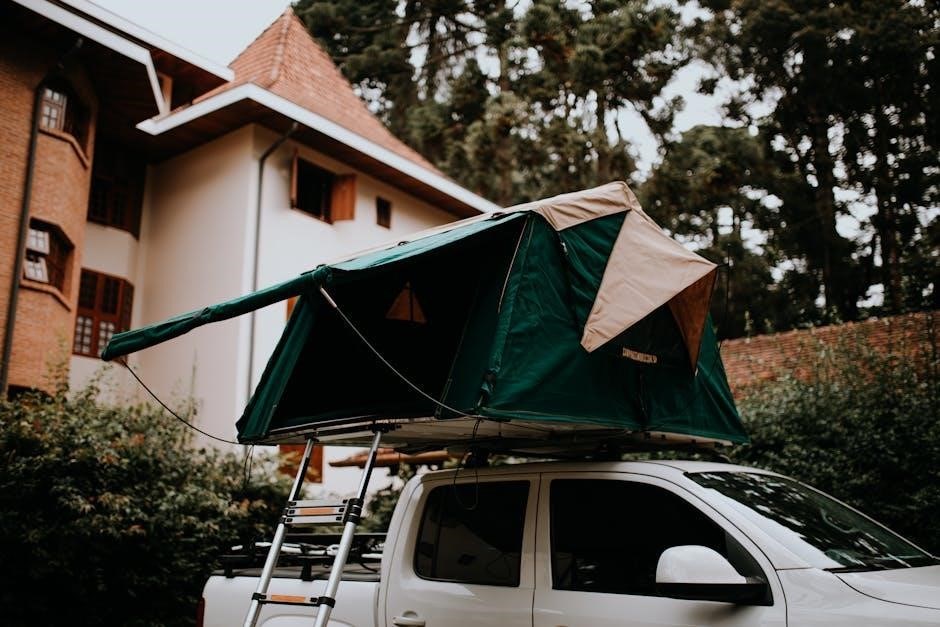
Types of Manual Awnings for Campers
- Retractable Manual Awnings: Can be rolled up for storage, offering versatility and convenience.
- Cassette Manual Awnings: Feature a self-contained design for easy retraction and protection from elements.
- Modular Manual Awnings: Allow customization with expandable sections for larger coverage areas.
- Standard Manual Awnings: Basic, lightweight options ideal for smaller campers and simple shading needs.
Made from durable materials like vinyl and aluminum, they offer reliable shade and protection for campers.
Standard Manual Awnings
Standard manual awnings are the most common type, offering simplicity and affordability for campers. They are typically fixed in size, made from durable materials like vinyl or fabric, and operate using a hand crank. Designed for easy setup, they provide reliable shade and weather protection. These awnings are lightweight, making them ideal for smaller campers or those seeking a no-frills solution. Available in various sizes, they are compatible with most RV types, including travel trailers and motorhomes. Their straightforward design ensures low maintenance and cost-effectiveness, making them a popular choice for campers who value ease of use and practicality.
Retractable Manual Awnings
Retractable manual awnings combine portability and functionality, offering easy setup and storage. These awnings feature spring-loaded arms that allow users to extend or retract the fabric with a hand crank. When not in use, they can be neatly stored, protecting the fabric from weather damage. Their lightweight and compact design makes them ideal for campers who frequently change locations. Available in various sizes and colors, retractable awnings provide versatility and convenience. They are a practical choice for campers seeking a balance between durability and ease of use, ensuring shade and comfort during outdoor adventures without the need for complex setups or electrical components.
Modular Manual Awnings
Modular manual awnings are designed for flexibility and customization, offering campers the ability to expand or adjust their shading system as needed. These awnings feature interchangeable sections that can be added or removed to suit different camping scenarios; Made from durable materials like heavy-duty vinyl, they provide long-lasting protection from the elements. Modular awnings are lightweight and easy to set up, making them ideal for campers who value versatility. Their adaptability ensures they can accommodate varying RV sizes and layouts, while their sleek designs enhance the overall camping experience. This makes them a practical choice for campers seeking a customizable shading solution.
Cassette Manual Awnings
Cassette manual awnings are a popular choice for campers, offering a sleek and compact design. These awnings feature a protective casing that houses the fabric when retracted, shielding it from dust and UV damage. Made from durable materials, they provide reliable shading and weather protection. Cassettes are easy to install and operate, requiring minimal effort to extend or retract. Their streamlined appearance integrates seamlessly with RV aesthetics, making them a stylish option. Available in various sizes and colors, cassette awnings are ideal for campers who value both functionality and visual appeal, ensuring a convenient and enjoyable outdoor experience.
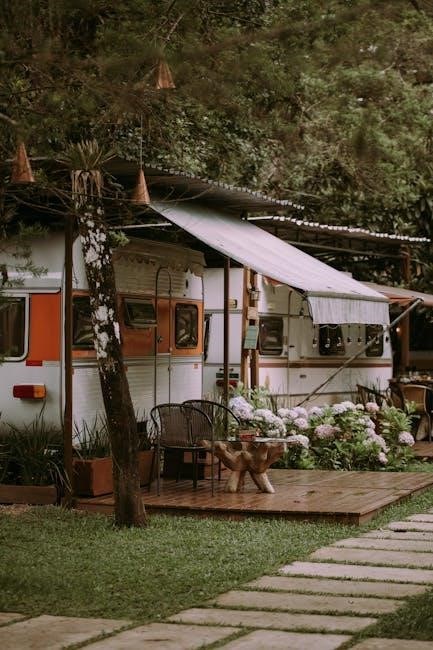
Key Features of Manual Awnings
Manual awnings offer size adaptability (8-21 ft), durable materials like 16 oz vinyl, 8 color options, and compatibility with motorhomes, trailers, and campers, ensuring versatile shading solutions.
Size and Fit Options
Manual camper awnings are available in various sizes, ranging from 8 to 21 feet, ensuring a perfect fit for different camper types, including motorhomes, trailers, and RVs. Popular brands like Awnlux and Dometic offer customizable options to match specific vehicle dimensions. The adjustable length and universal mounting systems provide flexibility, allowing users to secure the awning firmly. With sizes tailored to accommodate diverse camping needs, these awnings can cover patios, windows, or entire outdoor living spaces. This adaptability makes manual awnings a practical choice for campers seeking reliable shade without compromising on style or functionality.
Material and Durability
Manual camper awnings are crafted from durable materials like heavy-duty vinyl and weather-resistant fabrics, ensuring longevity and performance in harsh outdoor conditions. Many models feature UV-resistant and tear-resistant properties, maintaining their appearance and functionality over time; Aluminum alloy frames provide lightweight yet robust structural support, while double-sided vinyl fabrics enhance durability. Brands like Awnlux and Dometic use high-quality materials to withstand wind, rain, and sunlight, ensuring reliable shade and shelter. The combination of sturdy materials and weather-tight designs makes manual awnings a practical investment for campers seeking long-lasting performance and minimal maintenance.
Color and Design Variations
Manual camper awnings are available in a wide range of colors and designs to suit various camper styles and preferences. Many models offer up to 8 distinct color options, including neutral tones and vibrant hues, allowing campers to match their awning with their RV’s exterior; Striped patterns and solid colors are popular choices, providing both functionality and aesthetic appeal. Brands like Awnlux and Dometic offer custom designs, ensuring a seamless integration with camper aesthetics. The diverse color and design options enable campers to personalize their shading solution, enhancing both the functionality and visual appeal of their outdoor space.
Compatibility with Different RV Types
Manual awnings are designed to be compatible with a variety of RV types, including motorhomes, travel trailers, 5th wheels, and campers. They are engineered to fit seamlessly with different RV models, ensuring universal adaptability. Brands like Awnlux and Carefree offer awnings that work with major RV brands such as Dometic and Lippert. Whether you have a compact camper or a large motorhome, there’s a manual awning solution available. This versatility makes manual awnings a practical choice for RV owners seeking a reliable shading solution tailored to their specific vehicle, ensuring optimal performance and ease of use across different RV configurations and sizes.
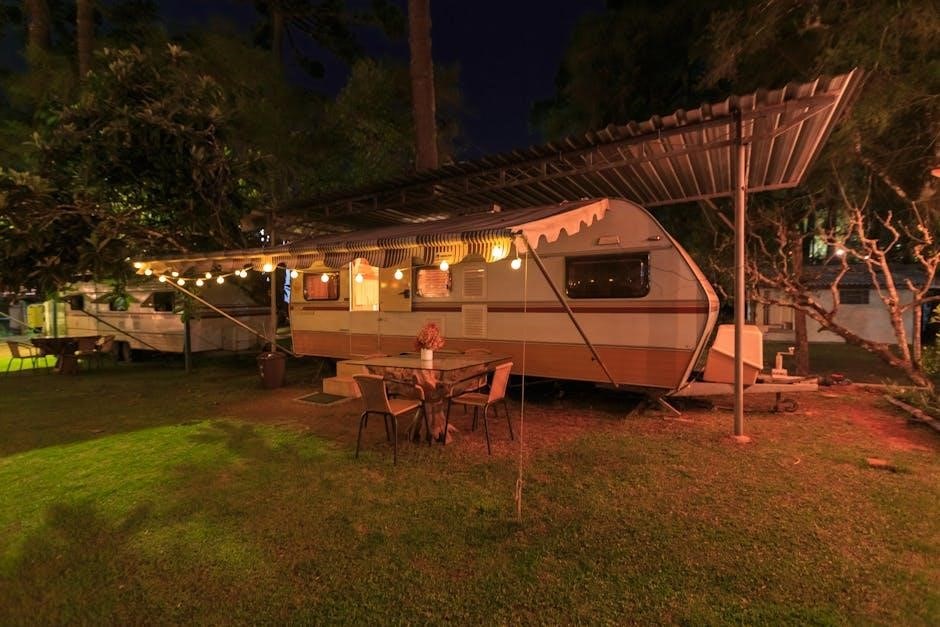
Installation and Setup
Manual awnings come with complete installation kits, including hardware and arms for easy setup. Follow step-by-step guides for proper alignment, leveling, and securement to your camper.
Step-by-Step Installation Guide
Installing a manual camper awning involves unpacking, measuring, and attaching mounting brackets to the RV. Secure the awning frame using lag bolts, ensuring proper alignment. Attach the fabric to the roller tube and connect the arms. Tighten all knobs and test the awning by extending and retracting it. Ensure the fabric is taut and the arms are fully secured. Follow manufacturer-specific instructions for precise setup, as some models may require additional steps. Proper installation ensures stability and prevents damage from wind or weather conditions. Always double-check alignment and hardware tightness for safe operation.
Tools and Hardware Required
Installing a manual camper awning requires specific tools and hardware. Essential tools include a drill, screwdrivers (Phillips and flathead), wrenches, and a measuring tape. Hardware needed consists of lag bolts, mounting brackets, and awning arms with knobs. Additional items like weatherstripping and sealant may be necessary to ensure a watertight installation. Always refer to the manufacturer’s manual for specific hardware requirements, as components may vary by brand. Ensure all tools and hardware are readily available before starting the installation process to avoid delays. Proper preparation guarantees a secure and functional setup for your camper awning.
Tips for Proper Alignment and Securement
Proper alignment and securement of your manual camper awning ensure stability and durability. Begin by measuring the RV’s sidewall to position the awning correctly. Use a spirit level to ensure the awning is straight during installation. Tighten rafter knobs firmly to prevent sagging and ensure the fabric is taut. Double-check fabric tension to avoid wrinkles or unevenness. For added stability, use awning straps or stakes in windy conditions. Regularly inspect the awning’s alignment and tighten any loose hardware. Proper securement prevents damage from weather and ensures reliable performance, enhancing your camping experience with a safe and functional shading solution.
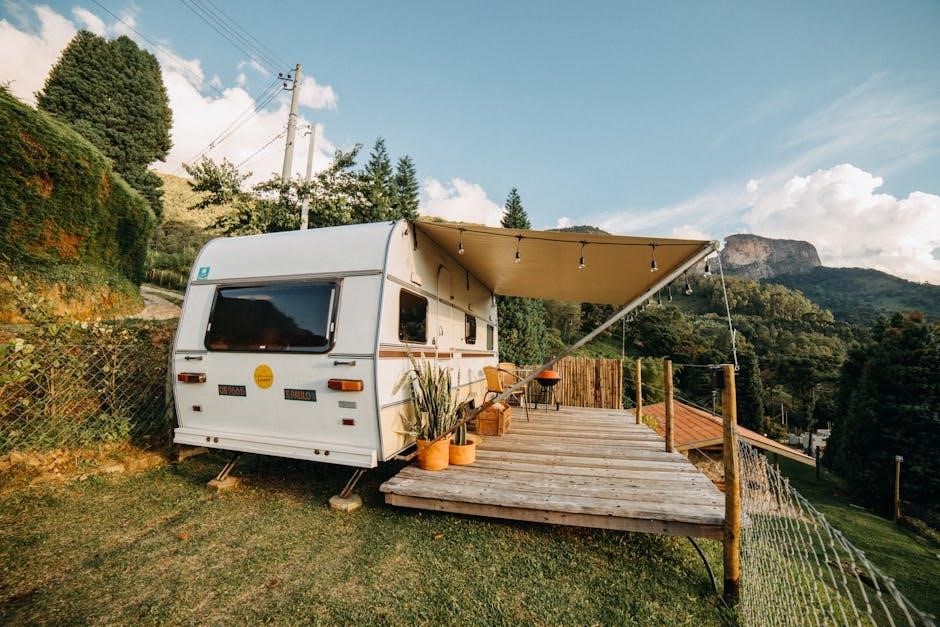
Maintenance and Care
Regular cleaning with mild soap and water prevents dirt buildup. Inspect for tears or wear, and repair promptly to maintain functionality. Store dry to avoid mildew.
Cleaning and Storing the Awning
Cleaning your manual camper awning is essential to maintain its durability. Use mild soap and water to wipe down the fabric, removing dirt and debris. Avoid harsh chemicals or abrasive cleaners, as they may damage the material. Regularly inspect the awning for stains or mildew and address them promptly. For storage, ensure the awning is completely dry to prevent mold or mildew buildup. Retract the awning fully and secure it with straps or clips. Store in a protective cover if possible. Proper cleaning and storage extend the life of your awning, ensuring it remains functional and visually appealing for future trips.
Inspecting for Damage and Wear
Regular inspection of your manual camper awning ensures longevity and functionality. Start by examining the fabric for tears, punctures, or signs of fading. Check the seams for gaps or weak points, as these can lead to leaks. Inspect the hardware, including hinges, springs, and arm brackets, for rust or wear. Look for any loose screws or bolts that may need tightening. The awning’s frame should be straight and free of dents. Addressing minor issues promptly prevents them from becoming major repairs. A thorough inspection before and after each camping season helps maintain your awning’s condition and performance, ensuring reliable shade and shelter.
Repairing Tears and Leaks
Repairing tears and leaks in your manual camper awning is essential to maintain its functionality; Start by cleaning the affected area to ensure proper adhesion. For small tears, use a vinyl repair patch kit, applying adhesive to both the patch and the awning before pressing firmly. For larger damage, consider professional-grade awning repair tape or fabric. Leaks often occur at seams, so apply a waterproof seam sealant. Regularly inspect and address minor issues to prevent further damage. Always follow the manufacturer’s instructions for specific materials, such as vinyl or fabric. Prompt repairs ensure your awning remains durable and leak-free for years of reliable use.
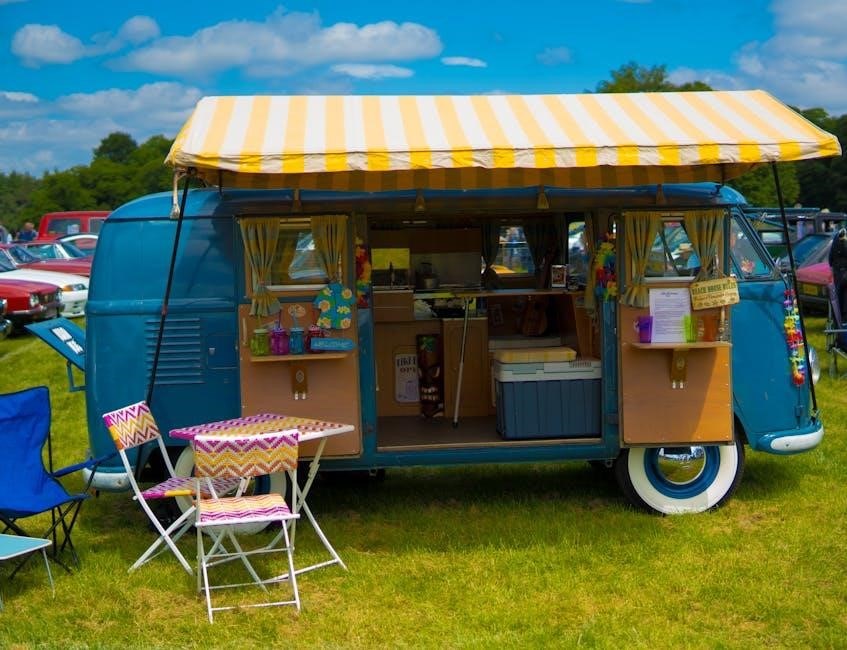
Troubleshooting Common Issues
Manual camper awnings may face issues like difficult retraction or leaks. Regular maintenance, proper alignment, and timely repairs can resolve these problems effectively, ensuring optimal performance.
Difficult Retraction or Extension
Difficult retraction or extension of manual camper awnings can stem from misalignment, tight springs, or worn-out parts. To resolve this, ensure the awning is properly aligned and lubricate moving components. If issues persist, inspect the springs and hardware for damage or corrosion, replacing them as needed. Regular maintenance, such as cleaning and lubricating hinges, helps prevent stiffness. Additionally, checking for obstructions like debris or fabric twists can address extension problems. Following these steps ensures smooth operation and extends the awning’s lifespan, providing reliable shade and shelter during camping trips.
Leaks or Water Damage
Leaks or water damage in manual camper awnings often occur due to improper sealing, torn fabric, or clogged water runoff systems. To address this, inspect the awning for cracks or gaps, especially at seams and hardware connections. Apply waterproof sealing products to compromised areas and repair or replace damaged fabric promptly. Regular cleaning and drying of the awning can prevent mildew and water spots. Ensuring proper pitch and angle during setup helps water run off effectively, reducing the risk of pooling and subsequent damage. Addressing leaks early prevents structural weakening and extends the awning’s lifespan for reliable shade and shelter.
Loose or Damaged Hardware
Loose or damaged hardware can compromise the stability and functionality of a manual camper awning. Regularly inspect bolts, screws, and brackets for tightness and wear. If components are loose, tighten them promptly to prevent further damage. Replace any rusted or corroded parts with durable, weather-resistant alternatives. Lubricate moving parts to ensure smooth operation and prevent seizing. Addressing hardware issues early avoids costly repairs and ensures the awning remains secure in windy conditions. Proper maintenance of hardware is essential for the longevity and safety of the awning, providing reliable shade and shelter during camping trips.
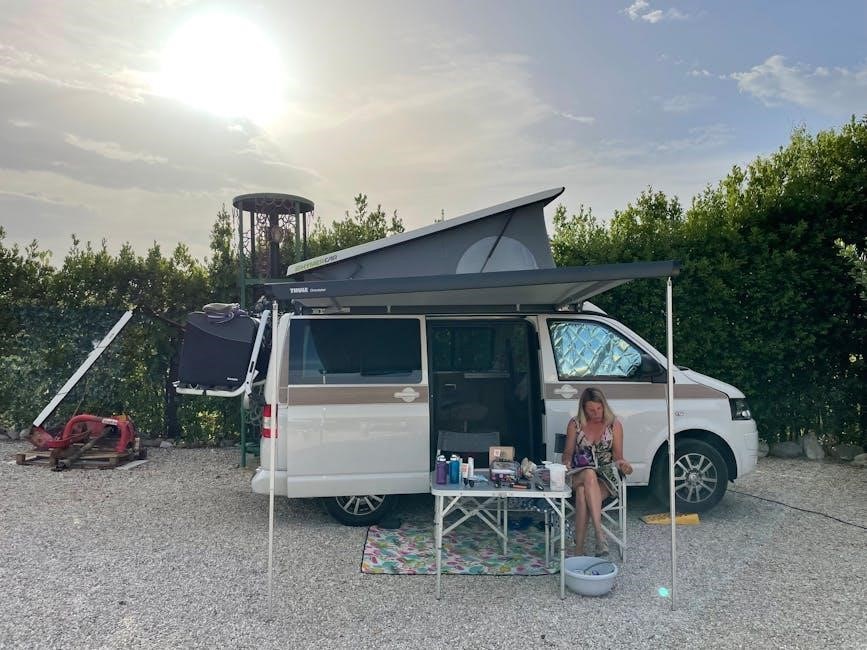
Comparing Manual vs. Automatic Awnings
Manual awnings offer simplicity and affordability with no electrical needs, ideal for off-grid camping. Automatic awnings provide convenience with motorized operation but at a higher cost and complexity.
Pros and Cons of Manual Awnings
Manual awnings are lightweight, portable, and require no electrical components, making them ideal for off-grid camping. They are cost-effective, easy to install, and offer low maintenance. However, they can be labor-intensive to set up and retract, especially in windy conditions. Manual awnings may also be less durable than automatic models and lack advanced features like sensors or remote controls. Despite these drawbacks, their simplicity and affordability make them a popular choice for campers seeking a straightforward shading solution without the hassle of complex systems.
Pros and Cons of Automatic Awnings
Automatic awnings offer effortless operation with the push of a button, making them ideal for convenience. They often feature advanced functions like wind sensors and automatic retraction, enhancing safety and ease of use. However, they are more expensive than manual awnings and require electrical power, which may not suit off-grid camping. Their complex mechanisms can also lead to higher maintenance needs. Despite these drawbacks, automatic awnings provide a modern, user-friendly experience, especially for those who value convenience and are willing to invest in premium features.
Cost Comparison
Manual awnings are generally more affordable, with prices starting around $500, while automatic awnings typically begin at $1,200. The cost difference arises from the complexity of automatic systems, which include motors and sensors. Installation for automatic awnings can add $300-$500, whereas manual awnings often require simpler, DIY-friendly setups. Over time, automatic awnings may incur higher maintenance costs due to their electrical components. However, their convenience and advanced features justify the investment for some users. Manual awnings remain the budget-friendly choice for campers seeking a straightforward, low-maintenance shading solution without the need for advanced technology.
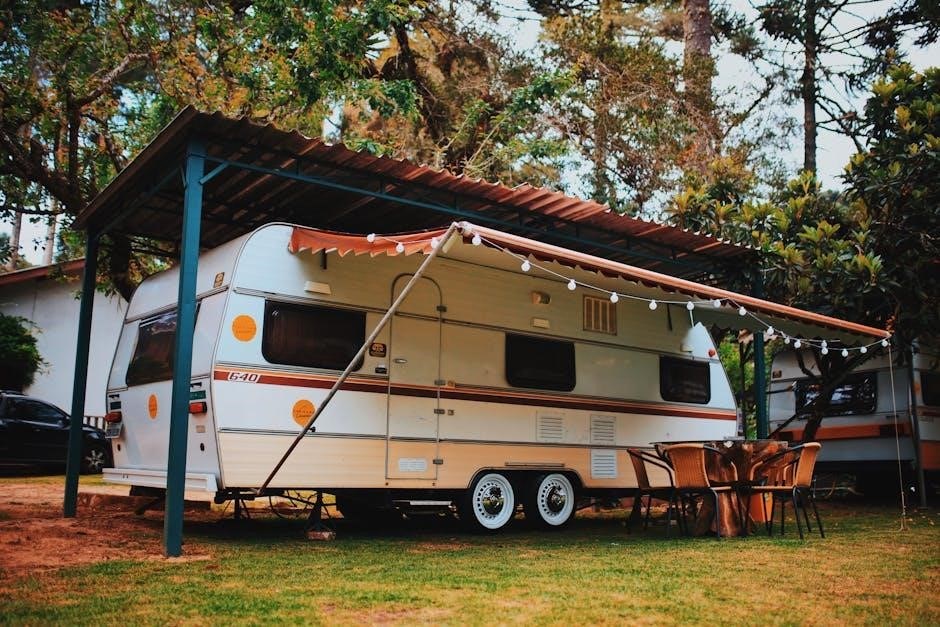
Advantages of Manual Awnings
Manual awnings are lightweight, portable, and require no electricity, making them ideal for off-grid camping. Their simple design ensures low maintenance and reliable performance, enhancing your camping experience.
Low Maintenance Requirements
Manual camper awnings are designed for minimal upkeep, ensuring a hassle-free experience. Their durable materials, such as 16 oz vinyl, resist weather and UV damage, reducing the need for frequent replacements. Regular cleaning with mild soap and water is sufficient to maintain their appearance and functionality. Unlike automatic awnings, manual models lack complex electrical components, eliminating issues related to wiring or motor failure. This simplicity makes them a practical choice for campers who prioritize ease of use and reliability. Additionally, their lightweight and portable design allows for easy storage and transportation, further enhancing their low-maintenance appeal.
No Electrical Components
Manual camper awnings eliminate the need for electricity, making them ideal for off-grid adventures. Without motors or wiring, these systems reduce the risk of electrical failures or power shortages. This simplicity also lowers the overall weight and cost compared to automatic awnings. Campers can enjoy reliable shade without relying on batteries or generators, ensuring uninterrupted use in remote locations. The absence of electrical components further enhances safety, as there are no risks associated with short circuits or electrical hazards. This makes manual awnings a practical, self-sufficient choice for campers seeking freedom from electrical dependencies while maintaining essential functionality.
Portability and Lightweight Design
Manual camper awnings are designed for portability and ease of transport, making them perfect for adventurers on the go. Their lightweight construction ensures they don’t add unnecessary weight to your camper, preserving fuel efficiency and handling. Compact designs allow for easy storage when not in use, while durable materials like vinyl and aluminum frames ensure they remain lightweight without compromising on strength. Many manual awnings, such as those from Awnlux and Carefree, are specifically engineered to be mobile-friendly, offering a practical solution for campers who value flexibility and ease of setup. This portability enhances the overall camping experience, making manual awnings a versatile choice.
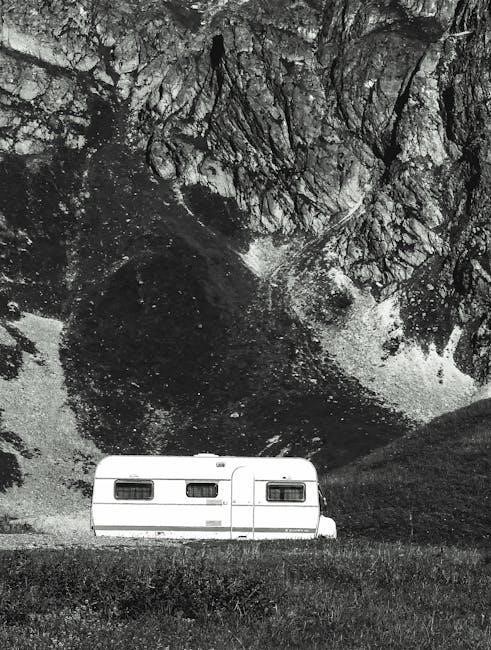
Future Trends in Manual Awnings
Future trends include innovative materials like lightweight, UV-resistant fabrics and integration with solar power for energy efficiency. Smart technology, such as app-controlled systems, is also emerging, enhancing functionality without compromising manual simplicity.
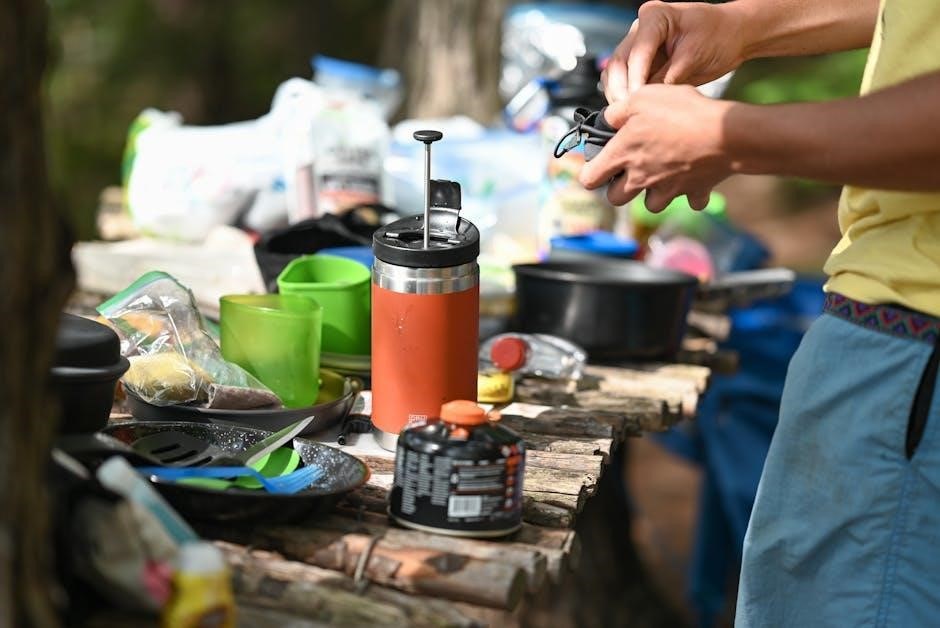
Innovative Materials and Designs
Innovative materials like lightweight, UV-resistant fabrics and durable vinyl are enhancing manual awnings’ performance. Designs now feature modular systems for easy expansion and customization. Solar-integrated awnings are emerging, combining shade with renewable energy generation. These advancements ensure longevity, reduce weight, and offer modern aesthetics, making manual awnings more practical and stylish for campers. Brands are also experimenting with frame materials, such as aluminum alloys, to improve strength without adding bulk. Such innovations cater to evolving camper needs, blending functionality with sleek designs for a seamless outdoor experience.
Integration with Solar Power
Manual awnings are now being integrated with solar power, offering campers a sustainable energy solution. Innovations like the Xpanse Solar Awning provide up to 1.2 kW of power, while Eco-dynamic Tech’s ARTPIECE generates 8,000 Wh daily. These systems embed solar panels into the awning fabric, allowing users to charge batteries or power appliances. This integration enhances off-grid camping capabilities, providing renewable energy while maintaining the simplicity of manual operation. Such designs not only reduce reliance on external power sources but also align with eco-friendly camping practices, making manual awnings more versatile and practical for modern campers seeking efficiency and sustainability.
Smart Technology in Manual Awnings
Smart technology is transforming manual awnings, enhancing functionality and user experience. Systems like the Altitude Smart Wireless Awning allow control via smartphones, enabling campers to adjust settings remotely. Sensors monitor wind and rain, automatically retracting the awning to prevent damage. Some models feature integrated timers and customizable settings, ensuring optimal shade and energy efficiency. These advancements merge traditional manual operation with modern automation, providing convenience without compromising the simplicity of manual systems. Smart technology is redefining how campers interact with their awnings, offering innovative solutions for hassle-free outdoor living.
Manual awnings for campers offer a practical, durable, and cost-effective solution for shading needs. Their simplicity, portability, and low maintenance make them ideal for outdoor enthusiasts seeking reliability and comfort.
Final Thoughts on Manual Awnings
Manual awnings for campers are a practical and reliable choice for outdoor enthusiasts. They offer simplicity, durability, and cost-effectiveness, making them ideal for campers seeking shade without complexity. Lightweight designs and easy operation ensure portability and ease of use, while high-quality materials like heavy-duty vinyl provide long-lasting performance. Compatible with various camper types, these awnings are perfect for off-grid adventures. With a range of sizes, colors, and styles available, manual awnings cater to diverse needs. Their low-maintenance requirements and absence of electrical components further enhance their appeal. For campers looking for a hassle-free shading solution, manual awnings remain a top choice.
Recommendations for Camper Owners
When selecting a manual awning for your camper, consider your specific needs, such as size, material, and color. Choose a reputable brand like Awnlux, Dometic, or Carefree for durability and reliability. Measure your camper accurately to ensure a proper fit, and opt for heavy-duty vinyl for longevity. Select a size between 8 to 21 feet, depending on your camper’s length, and pick a color that matches your vehicle’s style. For off-grid adventures, manual awnings are ideal due to their lightweight and low-maintenance design. Additionally, consider future trends like solar integration for enhanced functionality. Invest in a high-quality manual awning to elevate your camping experience.

